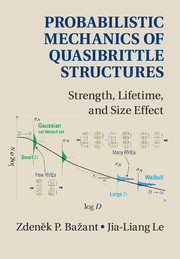Book contents
- Frontmatter
- Dedication
- Contents
- Foreword
- Preface
- 1 Introduction
- 2 Review of Classical Statistical Theory of Structural Strength and Structural Safety, and of Statistics Fundamentals
- 3 Review of Fracture Mechanics and Deterministic Size Effect in Quasibrittle Structures
- 4 Failure Statistics of Nanoscale Structures
- 5 Nano–Macroscale Bridging of Probability Distributions of Static and Fatigue Strengths
- 6 Multiscale Modeling of Fracture Kinetics and Size Effect under Static and Cyclic Fatigue
- 7 Size Effect on Probability Distributions of Strength and Lifetime of Quasibrittle Structures
- 8 Computation of Probability Distributions of Structural Strength and Lifetime
- 9 Indirect Determination of Strength Statistics of Quasibrittle Structures
- 10 Statistical Distribution and Size Effect on Residual Strength after Sustained Load
- 11 Size Effect on Reliability Indices and Safety Factors
- 12 Crack Length Effect on Scaling of Structural Strength and Type 1 to 2 Transition
- 13 Effect of Stress Singularities on Scaling of Structural Strength
- 14 Lifetime of High-k Gate Dielectrics and Analogy with Failure Statistics of Quasibrittle Structures
- Appendix A Power-Law Scaling of Boundary Value Problems
- Appendix B Proof of Transitional Size Effects of Types 1 and 2 by Dimensional Analysis and Asymptotic Matching up to Second Order
- Appendix C Proof of Small-Size Asymptotics of Cohesive Crack Model up to Second Order
- References
- Author Index
- Subject Index
4 - Failure Statistics of Nanoscale Structures
Published online by Cambridge University Press: 14 June 2017
- Frontmatter
- Dedication
- Contents
- Foreword
- Preface
- 1 Introduction
- 2 Review of Classical Statistical Theory of Structural Strength and Structural Safety, and of Statistics Fundamentals
- 3 Review of Fracture Mechanics and Deterministic Size Effect in Quasibrittle Structures
- 4 Failure Statistics of Nanoscale Structures
- 5 Nano–Macroscale Bridging of Probability Distributions of Static and Fatigue Strengths
- 6 Multiscale Modeling of Fracture Kinetics and Size Effect under Static and Cyclic Fatigue
- 7 Size Effect on Probability Distributions of Strength and Lifetime of Quasibrittle Structures
- 8 Computation of Probability Distributions of Structural Strength and Lifetime
- 9 Indirect Determination of Strength Statistics of Quasibrittle Structures
- 10 Statistical Distribution and Size Effect on Residual Strength after Sustained Load
- 11 Size Effect on Reliability Indices and Safety Factors
- 12 Crack Length Effect on Scaling of Structural Strength and Type 1 to 2 Transition
- 13 Effect of Stress Singularities on Scaling of Structural Strength
- 14 Lifetime of High-k Gate Dielectrics and Analogy with Failure Statistics of Quasibrittle Structures
- Appendix A Power-Law Scaling of Boundary Value Problems
- Appendix B Proof of Transitional Size Effects of Types 1 and 2 by Dimensional Analysis and Asymptotic Matching up to Second Order
- Appendix C Proof of Small-Size Asymptotics of Cohesive Crack Model up to Second Order
- References
- Author Index
- Subject Index
Summary
Damage and failure of a macroscale structure originate from the fracture of its nanoscale material elements, for example, a regular atomic lattice such as a single crystal grain of brittle ceramics, or a completely disordered structure such as a system of nanoparticles of the calcium silicate hydrate in concrete. Therefore, it is logical to begin with a study of the failure statistics of nanoscale structures to derive a probabilistic model for the failure of macroscale structures.
Background of Modeling of Nanoscale Fracture
With the advances in computational material sciences, multiscale analysis has been widely used to investigate the behavior of the macroscale structure from its meso- or nanoscale structures (Tadmor, Ortiz, & Phillips 1996; Ghoniem, Busso, Kioussis, & Huang 2003; Liu, Karpov, & Park 2005). Computational modeling of crack propagation in nanoscale structures, such as atomic lattices, largely relies on the use of empirical interatomic potentials (Omeltchenko, Yu, Kalia, & Vashishta 1997; Marder 2004; Khare et al. 2007, 2008; Xu et al. 2012). Recent research efforts have been directed to the coupling between the quantum mechanics (QM) and the molecular dynamics (MD) (Abraham, Broughton, Bernstein, & Kaxiras 1998; Broughton, Abraham, Bernstein, & Kaxiras 1999; Khare et al. 2007, 2008), which provides a more sound physical basis for the computational model.
However, these existing sophisticated numerical models are not suitable for studying the failure probability of nanoscale structures, especially when we are interested in the far left tail of the failure probability, which would require millions of numerical simulations. Meanwhile, the atomistic simulations are also not suitable for studying time-dependent fracture (e.g., static and cyclic fatigue), as the structural lifetime is many orders of magnitude longer than the vibration period of the atomic bond (Tadmor & Miller 2011). At the mesoscale level, there exists no physical law for the probability of microstructural failure, and only intuitive hypotheses and phenomenological models can be made. Therefore, the resulting failure statistics of macroscale structures strongly depends on these hypotheses and models about the mesoscale structural failure, which are often difficult to justify either physically or experimentally.
- Type
- Chapter
- Information
- Probabilistic Mechanics of Quasibrittle StructuresStrength, Lifetime, and Size Effect, pp. 59 - 70Publisher: Cambridge University PressPrint publication year: 2017



